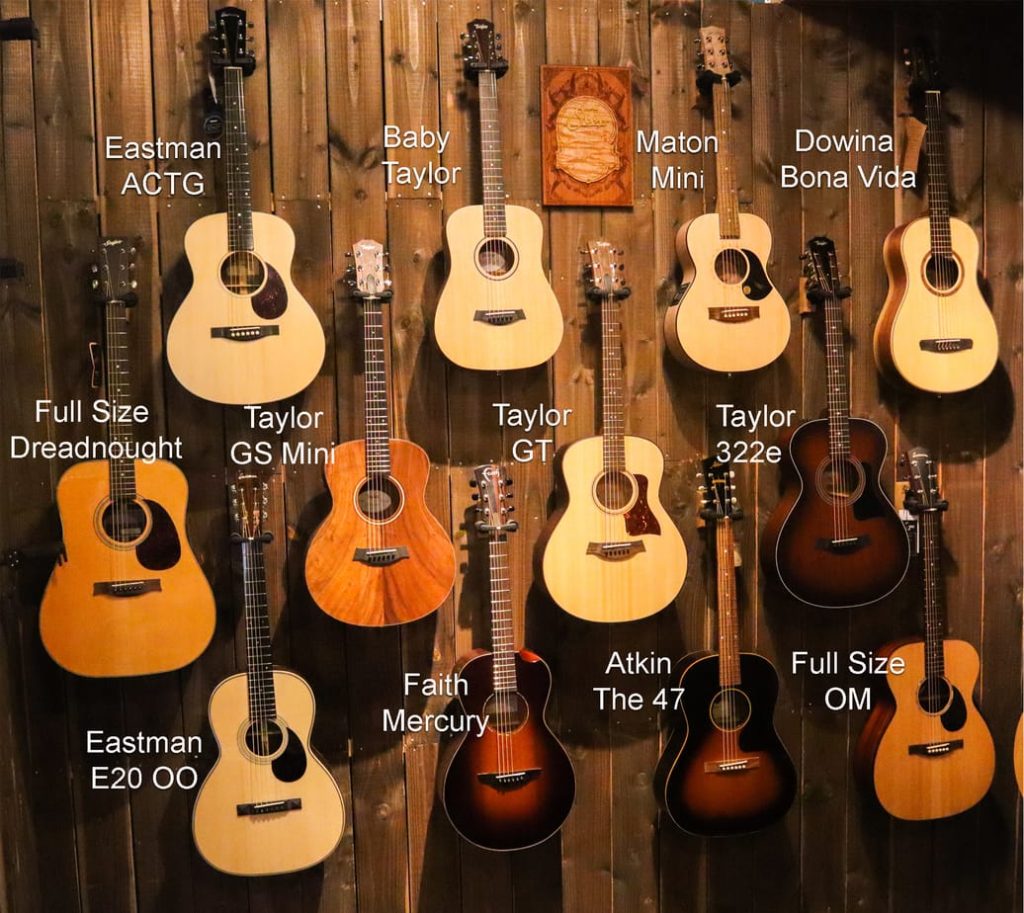The world according to Baas Kauffmann
The growing popularity of the smaller guitar
Small guitars are hip. More and more guitarists see something in the small guitar. And the range of small guitars is growing. More and more brands are offering smaller guitars, sometimes even entire series with different variants. You may be wondering “what am I supposed to do with a small guitar”? That is why we have listed some things worth knowing about the ‘small’ guitar for you.
The guitar instead of Spotify
In 1920, the largest guitar made then was the smallest you can buy today. The Parlor guitar was the standard at the beginning of the last century and derived its name from the place where it was most played, in the parlor or the living room. Without radio, TV, YouTube or Netflix, people were mainly dependent on each other for entertainment. Making music in any form was popular in all walks of life. And the parlor guitar fit the bill perfectly. It was relatively advantageous compared to the then hugely popular piano. It could be played by anyone who mastered three chords. Its sound and volume made it a practical accompaniment instrument for singers. And you have to imagine that at that time there was virtually no music other than live music. So if you wanted music you had to make it yourself or together.
From living room to battleship
It was not until the 1930s that the need for a larger guitar arose. Why? Because of the volume. More and more the guitar was used together with other instruments. And the guitar had a hard time keeping up with the piano in terms of volume, let alone a drum kit or wind instruments. Martin & Co developed the Orchestra Model (OM) which is now one of the best-selling guitar models. And shortly after, Martin launched the largest and loudest guitar on the market with the Dreadnought. The guitar took its name from a battleship that was then called a dreadnought. Gibson soon followed with the Jumbo (J-45) and later the Southern Jumbo (SJ-200). And with these guitars, country & western, folk and later pop history was written. The dreadnought and the OM are still the models we associate with the acoustic guitar.
How about volume?
So we play instruments that were mainly designed to sound loud. But that is of course no longer necessary. We have the electric guitar and we can actually consider it a very special instrument. And when we play acoustically, we can amplify almost any guitar if we need to. The volume no longer has to come from the design of the guitar. And more and more guitarists are realizing that a smaller
guitar has its advantages. If you play seated, a smaller guitar is more comfortable than a large one. A smaller guitar has a very unique sound. And maybe the less volume is an advantage. And finally, a growing number of guitarists feel the need to take the guitar with them when traveling. And especially if you are going to fly, a smaller guitar is easier and safer to carry. And maybe an open door, but if you’re six feet tall then a small guitar is a better and more comfortable option in all situations.
Parlors, Babies, Minis and Travel guitars.
There are quite a few brands that offer a small guitar. And in recent years, the variety of models has grown. In addition to the traditional parlor models, builders now also offer smaller guitars with a ‘more modern’ design. Referred to as a travel guitar, mini or baby guitar, these guitars look more like a ‘normal’ but somewhat small guitar. The parlor model has a typical appearance with its somewhat elongated body. Another important difference is in the scale length (length between the nut and bridge saddle) of the guitar. A Parlor model has a scale that is almost equal to ‘normal’ guitars, usually between 62 and 65 cm. The travel and mini guitars also offer shorter man hours, say between 57 and 63 cm. That difference does not seem that big, but in practice it is a real difference.
Ten times small
As we already wrote; the offer is huge. If by now you think that a smaller guitar is worth exploring, your search can begin. We have listed a few of the smaller guitars for you.
Baby Taylor
He looks really small. And yet it is only 25% smaller than the ‘big’ dreadnought. But it feels completely different. The scale length is 22 ¾ inches. This makes the Baby Taylor one of the smallest guitars. And that size also makes it particularly suitable for traveling and as a starter guitar for children. And with a price tag of $399, you’ve got a serious little guitar.
Taylor GS Mini
A step up is the Taylor GS Mini. And it immediately feels a lot more mature. With a scale length of 23 ½ inches and a body length of 45 cm, it is still a small guitar. The sound may be there. The guitar has sufficient bass and mids. The GS Mini is available in different versions and is available with and without an element. From €599,-
Maton Mini
The Maton Mini is a special guitar in this category. Maton is especially loved for its phenomenal amplified sound. The Maton Pro pickup is one of the best pickups for acoustic guitars. And that element is also in the Maton Mini. Moreover, this guitar is built completely solid. With a Spruce top and Queensland Maple back and sides, this guitar packs some serious specs. And that is also reflected in the price. The Maton Mini is available from €1285,- and is available in various versions.
Faith Nomad
The Nomad comes in two versions; a mini dreadnought made from Spruce/Mahogany and a Mini Grand Auditorium Mahogany version. In both cases the guitar is completely solid. In terms of dimensions, it is in the direction of the Taylor GS Mini with a scale length of 23 ¼ inches. The guitar is equipped with a Fishman cartridge with built-in tuner. The price is surprising. Because for €399,- you can take it with you, including travel cover.
Taylor GT
With the GT, Taylor is aiming very cleverly at the segment between the small guitar and the full size guitar. The Taylor GT has all the hallmarks of an American Series Taylor. The guitar is made of solid wood, a Spruce top and Urban Ash back and sides. Urban Ash is one of Taylor’s contributions to carefully handling increasingly scarce tonewoods. Taylor Urban Ash is made from wood that has been harvested from the inner cities of the USA and that would normally not be processed. The guitar has a scale length of 24 1/8 inch and feels pleasant on your lap. The GT is a responsive guitar with a sweet tone. The GT comes with and without cartridge. From €1599,-
Eastman ACTG
The Eastman Travel Guitar is the same size as the Taylor GS Mini. And it comes in two versions. The AC TG1 has a laminated side and back and a solid spruce top. The ACTG 2E is completely solid and has an Ovangkol side and back and a Spruce top. In addition, it is equipped with a Fishman Sonitone pickup. From €419,-
Faith Mercury 12th fret Classic
The elongated body of the Faith Mercury looks like a real parlor guitar. With a 24 inch scale and the body that touches the neck at the 12th fret, the Faith Mercury feels wonderfully compact. The neck feels firm and wide. The guitar sounds surprisingly ‘large’ and the small cutout in the top makes higher positions than the 12th still accessible. With a solid red cedar top and mahogany back and sides, the guitar has a warm, slightly compressed sound. The Mercury is available in different versions and the price is from €625,-
Dowina Bona Vida
What a well-chosen name for a guitar. With the good life I imagine a sun-drenched afternoon in a flowery garden with a nice guitar on my lap and something beautiful in the glass. This Dowina certainly qualifies for that. It has a classic parlor shape with an elongated body and a ‘normal’ scale length of 25.5 inches. The Downina BV is available in different variants, but they are all made of solid wood. There is quite a difference in sound due to the types of wood used. The top model has a Dolomite Spruce top and Cocobolo sides and back. And this sounds great and is a feast for the eyes. The Dowina Bona Vida is available from €799,-
Taylor 322 12th fret
This Grand Concert model features Tasmanian Blackwood back and sides and a Mahogany top. The Taylor 322e is compact but the scale length has an almost ‘normal’ length of 24 7/8 inches. Still, the guitar feels compact as the body joins the neck at the 12th fret instead of the 14th fret. The guitar plays smoothly and lightly, also thanks to Taylor’s unique neck construction. For a guitar like this you can dig a little deeper into your pocket, €
Eastman E20-00
The Eastman OO also has a nice compact body and the neck touches the body at the 12th fret. The neck is quite wide and that makes the guitar ideally suited for finger picking. The guitar also looks traditional due to the open slot headstock. Of course, this Eastman is completely solid with a Spruce top and Rosewood sides and back. And that ensures nice bass and clear highs. The Eastman E20 OO costs €1650,- and for that you have a very good sounding guitar.
Atkin the 47
There are also many smaller guitars in the higher segment. The Atkin the 47 is not only a smaller but a very light built guitar. The scale is 24 7/8. Slightly smaller than a ‘normal’ guitar. The body shape is inspired by an LG2. And with its sunburst top and aged finish, this is a guitar with a high vintage character. It is a great resonant guitar with a nice volume and nice accent on the highs. You can stay inspired by this for hours.


Everyone loves it when folks get together and share thoughts.
Great website, stick with it!
Thanks! And we will.
Everything is very open with a clear clarification of the challenges.
It was really informative. Your website is useful. Many thanks for sharing!
Thank you!
As far as I know the Eastman ACTG models are both all solid.
Hey Herrie, yes you are right the are. Thanks!